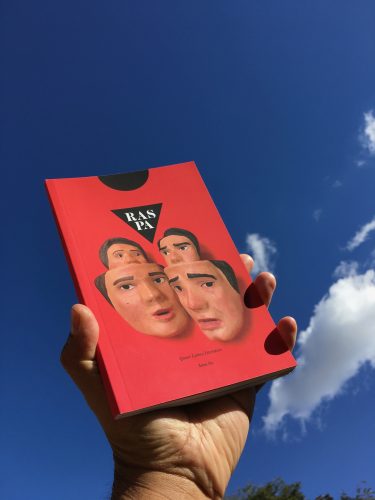Spotlight on New Queer Literature: A Conversation with Raspa Magazine

Author: Alyssa C. Greene
January 15, 2019
“Our intent is to cultivate an environment that empowers art makers to push boundaries in their process, redefine the literary canon, and reshape art to be more representative and inclusive.”
Spotlight on New Queer Literature is a monthly series highlighting publications that are LGBTQIA owned, promote queer and trans writers, or publish work on LGBTQIA themes, seeking to connect Lambda’s readership with contemporary queer publishers and authors.
To ring in the new year, Lambda spoke with César Ramos, founder and editor of Raspa Magazine, a print magazine dedicated to queer Latinx literature. We spoke about Raspa‘s dedication to artistic innovation, representation, and community building.
Tell us a little bit about Raspa and its mission.
 Raspa Magazine is a response to paucity of queer Latinx literature readily available to readers. Through the creation of a print publication my goal was to exhibit the experiences of the queer Latinx, thereby providing a better understanding for our selves as peers and for those outside of our community. It was founded on the values of equal representation, dedication to the arts, community building, and exemplifying Latinx leadership. These values stem from my own personal beliefs of equality, healing through creation, and community service. My decisions, as editor, are guided by these values. Every issue, every visual artist selected, every creative piece is carefully curated to demonstrate the talent and the diversity within our own Latinx community. These same values grant me the freedom to promote work that may not be accepted in conventional literary circles but are important for what they represent to us; that our voice matter, and that our experiences are valid.
Raspa Magazine is a response to paucity of queer Latinx literature readily available to readers. Through the creation of a print publication my goal was to exhibit the experiences of the queer Latinx, thereby providing a better understanding for our selves as peers and for those outside of our community. It was founded on the values of equal representation, dedication to the arts, community building, and exemplifying Latinx leadership. These values stem from my own personal beliefs of equality, healing through creation, and community service. My decisions, as editor, are guided by these values. Every issue, every visual artist selected, every creative piece is carefully curated to demonstrate the talent and the diversity within our own Latinx community. These same values grant me the freedom to promote work that may not be accepted in conventional literary circles but are important for what they represent to us; that our voice matter, and that our experiences are valid.
How long has Raspa been around? How has it developed or changed since it began?
Raspa Magazine was established in 2012. Since its inception, it was intended to serve as a literary based initiative to assist marginalized communities increase representation, improve accessibility, and achieve greater artistic merit in the literary arts. In the beginning, my team and I worked toward this goal solely through the publication of the magazine. Over time, with gained professional experience, overwhelming community support, and some difficult conversations, we have been able to expand on our original efforts and develop programming that helps us become a more impactful platform. The magazine itself, now boast contributors from the United States, Mexico, Central and South America, with an increase in Spanish language works. Raspa Magazine also organizes Rough Nights: A Reading Series. A yearly reading event that connects audiences and featured authors in a way that expands past the page. It is an effort to foster deep and meaningful conversations for better understanding through increased visibility and access. Raspa also develops community collaborations with community members who identify as queer, or as Latinx, but not both. The intended goal is to explore the intersectionality of identities through in depth creative written work that
What kind of work do you publish?
Raspa Magazine publishes creative written work and visual art that narrates the queer Latinx experience. We do not focus on genre or form, but on artistic merit, innovativeness, and potential cultural impact. Raspa Magazine serves as a sustainable space for queer Latinx artist to share work without the fear of being tokenized, with liberty to experiment, and create work with the knowledge that it will be treated with dignity and respect. Our intent is to cultivate an environment that empowers art makers to push boundaries in their process, redefine the literary canon, and reshape art to be more representative and inclusive.
How would you describe Raspa’s aesthetic?
The queer, Latinx experience is diverse. We encourage contributors to embody their own experience through their work, how they see fit. We do not expect contributors to adhere to a tone, style, form, or genre. What we do expect is artistic excellence, quality and innovative creative written work, and thoughtful story telling. Each issue has no theme. It is a cross section of work being created at the moment, with varying conversations occurring within a single issue. We believe this allows for a more accurate representation of the queer, Latinx community.
Can you highlight some of the work Raspa publishes?
 “After Citlalli Died” and “Following Alfonsina” by mónica teresa ortiz are two poems that were published in our inaugural issue. mónica’s language manages to express genuine sentimentality through powerful imagery without becoming cliché. mónica is a skilled poet that manages to convey universal experiences in a few stanzas, if not in a single one, that offer magnetic and beautiful perspectives. After working with her as contributor on the first issue, I immediately recognized a social conscious, skilled writer and asked her to join our team as poetry editor.
“After Citlalli Died” and “Following Alfonsina” by mónica teresa ortiz are two poems that were published in our inaugural issue. mónica’s language manages to express genuine sentimentality through powerful imagery without becoming cliché. mónica is a skilled poet that manages to convey universal experiences in a few stanzas, if not in a single one, that offer magnetic and beautiful perspectives. After working with her as contributor on the first issue, I immediately recognized a social conscious, skilled writer and asked her to join our team as poetry editor.
“To Kill a Mariposa” by Juliana Delgado Lopera is an intense short story about a queer and gender non-conforming Mario. The story takes us through several humiliating acts of physical and emotional abuse at the hands of his parents, and his final act of defiance before escaping his turbulent home. I appreciate this story because Mario, the protagonist, is unapologetically queer. He remains true to himself despite the abusive attempts by his parents to challenge his behavior. Mario, is also flawed and his misguided decisions lead to an aggressive and violent confrontation. The story illustrates the importance of allowing queer youth to express themselves and it serves as a cautionary tale about the dangers of repressing queer youth.
“Three Scenes Explaining a Theory of Restraint” by Marcos Santiago Gonsalez is an essay written in three sections, with each section discussing a significant person in the author’s life. Collectively they offer insight on how interpersonal relationship can shape our identities, and how those relationships can impact our own relationship with ourselves. I appreciate a good essay, and even more when I can relate to the topic on multiple levels. Marcos pulls from his personal history to create writings that are intimate and vulnerable but speak to the Latinx experience, writing about topics seldomly discussed in our community.
What would you like writers and artists interested in submitting to Raspa to know?
I am often asked if submissions need to be about Latinidad and/or queerness to be considered for publication, to which I answer no! We would like for potential contributors to submit work about anything and everything they feel is important to them. Raspa Magazine is a queer, Latinx literary magazine, which means we will consider work by anyone who self-identifies as queer and Latinx. We, as a community of marginalized artist, already face an oppressive arts industry that supports and props up work that aligns with their pre-conceived notions of our cultural and sexual identity, and we are here to undermine those efforts.
Raspa Magazine is currently a print publication only. Historically, print media has been inaccessible to marginalized communities. It was difficult for queer artist of color to be included in literary magazines, anthologies, and art catalogs. We feel it is important that queer writers of colors be able to experience the joy of seeing their work manifest itself in a very real and tangible form. My team and I work diligently to produce a publication with high production value to not only match the quality content entrusted to Raspa, but as a sign of respect for the contributors selected.

